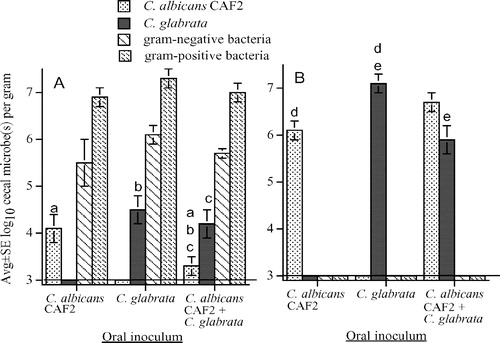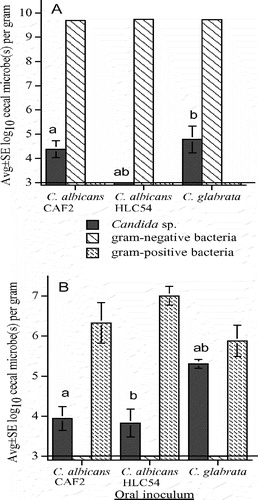Figures & data
Table I. Summary of eight experimental mouse models describing cecal bacterial flora, orally inoculated Candida species, numbers of mice per treatment group, and where data describing Candida colonization are presented.*
Figure 1. Cecal flora after oral inoculation of 107C. albicans CAF2 (wild type), or 107C. glabrata, or both Candida spp. into untreated mice (A) and into mice pretreated with bacitracin, streptomycin, and gentamicin to eliminate detectable cecal bacteria (B). The lower limit of assay detection is 3.0 log10/g indicated by a horizontal line. Bars with the same letters (a or b) differ at p≤0.05 and bars with the same letters (c, d, or e) differ at p≤0.01.

Figure 2. Cecal flora after oral inoculation of 107C. albicans HLC54 (defective in filament formation), or 107C. glabrata, or both Candida spp., into untreated mice (A) and into mice pretreated with bacitracin, streptomycin, and gentamicin to eliminate detectable cecal bacteria (B). The lower limit of assay detection is 3.0 log10/g indicated by a horizontal line. Bars with the same letters (a or f) differ at p≤0.05 and bars with the same letters (b, c, d, or e) differ at p≤0.01.

Figure 3. Cecal flora of mice pretreated with streptomycin and bacitracin (to eliminate detectable cecal bacteria) followed by oral inoculation with streptomycin-resistant E. coli mixed with either wild-type C. albicans CAF2, mutant C. albicans HLC54, or C. glabrata (A), and cecal flora of mice pretreated with streptomycin (to selectively eliminate aerobic/facultative gram-negative bacteria) before oral inoculation with wild-type C. albicans CAF2, mutant C. albicans HLC54, or C. glabrata (B). The lower limit of assay detection is 3.0 log10/g indicated by a horizontal line. Error bars not apparent if < 0.1. Bars with the same letters (a or b) differ at p < 0.01.

Table II. Effect of C. glabrata on 24-h growth of C. albicans CAF2 (wild type) and HLC54 (filamentation-defective mutant) in broth culture following inoculation of 105/ml of each yeast.
Table III. Summary of statistically significant differences in the concentrations of C. glabrata compared to C. albicans CAF2 and C. albicans HLC54, following in vitro inoculation (broth culture) and in vivo inoculation (normal and antibiotic-treated mice) of pure and mixed cultures.